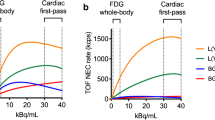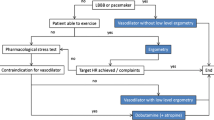Abstract
Background
Clinical utility of myocardial delayed enhancement CT has not been reported in children and young adults.
Objective
To describe initial experience of myocardial delayed enhancement CT regarding image quality, radiation dose and identification of myocardial lesions in children and young adults.
Materials and methods
Between August 2013 and November 2016, 29 consecutive children and young adults (median age 16 months) with suspected coronary artery or myocardial abnormality underwent arterial- and delayed-phase cardiac CT at our institution. We measured CT densities in normal myocardium, left ventricular cavity, and arterial and delayed hypo-enhancing and delayed hyperenhancing myocardial lesions. We then compared the extent of delayed hyperenhancing lesions with delayed-enhancement MRI or thallium single-photon emission CT.
Results
Normal myocardium and left ventricular cavity showed significantly higher CT numbers on arterial-phase CT than on delayed-phase CT (t-test, P<0.0001). Contrast-to-noise ratios of the arterial and delayed hypo-enhancing and delayed hyperenhancing lesions on CT were 26.7, 17.6 and 18.7, respectively. Delayed-phase CT findings were equivalent to those of delayed-enhancement MRI in all cases (7/7) and to those of thallium single-photon emission CT in 70% (7/10).
Conclusion
Myocardial delayed-enhancement CT can be added to evaluate myocardial lesions in select children and young adults with suspected coronary artery or myocardial abnormality.








Similar content being viewed by others
References
Higgins CB, Sovak M, Schmidt W et al (1979) Differential accumulation of radiopaque contrast material in acute myocardial infarction. Am J Cardiol 43:47–51
Abraham JL, Higgins CB, Newell JD (1980) Uptake of iodinated contrast material in ischemic myocardium as an indicator of loss of cellular membrane integrity. Am J Pathol 101:319–330
Higgins CB, Siemers PT, Newell JD et al (1980) Role of iodinated contrast material in the evaluation of myocardial infarction by computerized transmission tomography. Investig Radiol 15:S176–S182
Jacquier A, Revel D, Saeed M (2008) MDCT of the myocardium: a new contribution to ischemic heart disease. Acad Radiol 15:477–487
Koyama Y, Matsuoka H, Mochizuki T et al (2005) Assessment of reperfused acute myocardial infarction with two-phase contrast-enhanced helical CT: prediction of left ventricular function and wall thickness. Radiology 235:804–811
Nieman K, Shapiro MD, Ferencik M et al (2008) Reperfused myocardial infarction: contrast-enhanced 64-section CT in comparison to MR imaging. Radiology 247:49–56
Zhao L, Ma X, Feuchtner GM et al (2014) Quantification of myocardial delayed enhancement and wall thickness in hypertrophic cardiomyopathy: multidetector computed tomography versus magnetic resonance imaging. Eur J Radiol 83:1778–1785
Esposito A, Palmisano A, Antunes S et al (2016) Cardiac CT with delayed enhancement in the characterization of ventricular tachycardia structural substrate: relationship between CT-segmented scar and electro-anatomic mapping. JACC Cardiovasc Imaging 9:822–832
Taylor AM, Dymarkowski S, Hamaekers P et al (2005) MR coronary angiography and late-enhancement myocardial MR in children who underwent arterial switch surgery for transposition of great arteries. Radiology 234:542–547
Etesami M, Gilkeson RC, Rajiah P (2016) Utility of late gadolinium enhancement in pediatric cardiac MRI. Pediatr Radiol 46:1096–1113
Goo HW (2011) Individualized volume CT dose index determined by cross-sectional area and mean density of the body to achieve uniform image noise of contrast-enhanced pediatric chest CT obtained at variable kV levels and with combined tube current modulation. Pediatr Radiol 41:839–847
Goo HW, Suh DS (2006) The influences of tube voltage and scan direction on combined tube current modulation: a phantom study. Pediatr Radiol 36:833–840
Israel GM, Herlihy S, Rubinowitz AN et al (2008) Does a combination of dose modulation with fast gantry rotation time limit CT image quality? AJR Am J Roentgenol 191:140–144
Mendoza DD, Joshi SB, Weissman G et al (2010) Viability imaging by cardiac computed tomography. J Cardiovasc Comput Tomogr 4:83–91
Deak PD, Smal Y, Kalender WA (2010) Multisection CT protocols: sex- and age-specific conversion factors used to determine effective dose from dose-length product. Radiology 257:158–166
Goo HW (2012) CT radiation dose optimization and estimation: an update for radiologists. Korean J Radiol 13:1–11
Cerqueira MD, Weissman NJ, Dilsizian V et al (2002) Standardized myocardial segmentation and nomenclature for tomographic imaging of the heart: a statement for healthcare professionals from the cardiac imaging Committee of the Council on clinical cardiology of the American Heart Association. Circulation 105:539–542
Wang R, Zhang Z, Xu L et al (2011) Low dose prospective ECG-gated delayed enhanced dual-source computed tomography in reperfused acute myocardial infarction comparison with cardiac magnetic resonance. Eur J Radiol 80:326–330
Goetti R, Feuchtner G, Stolzmann P et al (2011) Delayed enhancement imaging of myocardial viability: low-dose high-pitch CT versus MRI. Eur Radiol 21:2091–2099
Mahnken AH, Bruners P, Muhlenbruch G et al (2007) Low tube voltage improves computed tomography imaging of delayed myocardial contrast enhancement in an experimental acute myocardial infarction model. Investig Radiol 42:123–129
Paul JF, Wartski M, Caussin C et al (2005) Late defect on delayed contrast-enhanced multi-detector row CT scans in the prediction of SPECT infarct size after reperfused acute myocardial infarction: initial experience. Radiology 236:485–489
Nikolaou K, Knez A, Sagmeister S et al (2004) Assessment of myocardial infarctions using multidetector-row computed tomography. J Comput Assist Tomogr 28:286–292
Koyama Y, Mochizuki T, Higaki J (2004) Computed tomography assessment of myocardial perfusion, viability, and function. J Magn Reson Imaging 19:800–815
Mahnken AH, Bruners P, Friman O et al (2010) The culprit lesion and its consequences: combined visualization of the coronary arteries and delayed myocardial enhancement in dual-source CT: a pilot study. Eur Radiol 20:2834–2843
Chang HJ, George RT, Schuleri KH et al (2009) Prospective electrocardiogram-gated delayed enhanced multidetector computed tomography accurately quantifies infarct size and reduces radiation exposure. JACC Cardiovasc Imaging 2:412–420
Lardo AC, Cordeiro MA, Silva C et al (2006) Contrast-enhanced multidetector computed tomography viability imaging after myocardial infarction: characterization of myocyte death, microvascular obstruction, and chronic scar. Circulation 113:394–404
Goo HW (2015) Coronary artery imaging in children. Korean J Radiol 16:239–250
Goo HW (2013) Current trends in cardiac CT in children. Acta Radiol 54:1055–1062
Goo HW, Yang DH (2010) Coronary artery visibility in free-breathing young children with congenital heart disease on cardiac 64-slice CT: dual-source ECG-triggered sequential scan vs. single-source non-ECG-synchronized spiral scan. Pediatr Radiol 40:1670–1680
Goo HW, Seo DM, Yun TJ et al (2009) Coronary artery anomalies and clinically important anatomy in patients with congenital heart disease: multi-slice CT findings. Pediatr Radiol 39:265–273
Kim HJ, Goo HW, Park S et al (2013) Left ventricle volume measured by cardiac CT in an infant with a small left ventricle: a new and accurate method in determining uni- or biventricular repair. Pediatr Radiol 43:243–246
Goo HW, Park SH (2015) Semiautomatic three-dimensional CT ventricular volumetry in patients with congenital heart disease: agreement between two methods with different user interaction. Int J Cardiovasc Imaging 31:223–232
Author information
Authors and Affiliations
Corresponding author
Ethics declarations
Conflicts of interest
None
Rights and permissions
About this article
Cite this article
Goo, H.W. Myocardial delayed-enhancement CT: initial experience in children and young adults. Pediatr Radiol 47, 1452–1462 (2017). https://doi.org/10.1007/s00247-017-3889-7
Received:
Revised:
Accepted:
Published:
Issue Date:
DOI: https://doi.org/10.1007/s00247-017-3889-7




